How to choose a sleeping bag for tourism
Everyone knows how important for a person's sleep. Complete rest is especially necessary in extreme or unusual conditions. Under these concepts fall sport expeditions, hiking trips and even regular trips into the field with an overnight stay. In such circumstances, a sleeping bag will need to ensure a comfortable sleep. At the moment, due to the abundance of offerings on the market it becomes very difficult to choose a product that will last for many years, and will be comfortable and undemanding in care. We will try to help. This article will tell you how to choose a sleeping bag. Let's get started.
Types sleeping
In appearance they are of three types: a blanket cocoon and combined.
1. Blanket
Rectangular bag. Lightning is located around the perimeter. How to choose a sleeping bag quilt read below. In the meantime, we confine ourselves to its description. This option is suitable for simple hikes, with no restrictions on the volume and weight of things. Bags of this type are very comfortable to sleep, as well as their possible pairing. At full unzipping, sleeping becomes a regular blanket.
2. Cocoon
Different anatomical shape (the upper part is wide, and the bottom - narrow). Due to her bag in the backpack takes up little space and is lighter in weight. In addition, it is quite tightly hugs the body, which is very important for cold camping conditions. In addition to anatomical hood, the models of this type have warmed collar and valve and insulated lower part (for extreme hiking). All internal and external seams are offset relative to each other for better heat preservation.
3. Combined
These are products such as "blankets", but with the presence of anatomical hood, tighten the tie with a corkscrew.
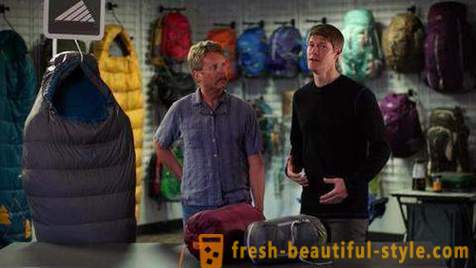
Temperature settings
People who are just planning to go hiking, and really do not understand how to choose a sleeping bag, very often do not take into account this nuance. And it is very important! Of course, there is a sleeping bag, suitable for spending the night on a fishing trip, and the expedition to the mountains. But in any bag has 2 heat modes: comfort temperature (at which a person can sleep in the tent) and extreme temperature (at which it is possible to sleep in the open space). comfort temperature - the amount of heat, allowing sleep peacefully throughout the night. The upper figure (for example, 10 to C) means that when unbuttoned sleeping bag and fold the hood tourist will not overheat. The lower figure - is the limit at which a sleeping bag should be properly buttoned warm sleeping at night in tents.
The value assumes extreme temperature protection from strong tourist supercooling. How comfortable it would be to sleep in such conditions, that is another question. Usually this thermal regime pay attention climbers trained athletes and people who intend to hike on flat terrain during periods when there are no strong differences in nighttime temperatures (summer and spring).
With respect to the temperature of sleeping European standard EN13537 called, was adopted in 2002. A great contribution to its development made Outdoor Group companies. Three years later, this standard is introduced everywhere. This obliged producers to determine the thermal regime of sleeping laboratory methods. Of course, each brand had its own indicators, but later just unified.

using seasonal
According to a seasonal sleeping bags are divided into: winter, summer and off-season.
Winter 1.
It is the most voluminous, warm and heavy products with an extreme value of the temperature to -45 to C. There are downy or sandwich. If you have down-filled bag, let him the opportunity to dry. Otherwise filler go astray in lumps, and the product will lose its characteristics. For more information about how to choose a winter sleeping bag, there are in this article. We tell you about other options.
2. Summer
Temperature comfort these bags 5 above to C. The number of layers depends on what have insulation quality. But most of all in summer sleeping bags one, maximum two layers.
3. Intra-seasonal
extreme temperature ranges from -17 to C to -2 to C. In most cases have the same appearance as that of the cocoon. Usually the question "How to choose a sleeping bag off-season?" No drives to a screeching halt even the novice travelers. It is connected with the fact that these models are available in a few companies, but because there is a huge variety of options. Depending from the lower temperature and quality, contain 2-3 insulation layer. Inter-seasonal sleeping most versatile - they can be used in the summer, spring and autumn. They are also suitable for regions with mild winters.
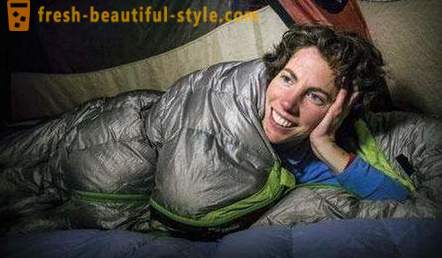
Materials sleeping
Fans with the experience of hiking will remember the days when there were on sale the first tourist sleeping bags. How to choose a similar product with a quality insulation, nobody even thought about it. Then there was only one filler - Cotton (cotton). Of course, wool retains heat well. And this is her only advantage. On the other hand, cotton sleeping poorly dried, weighed a lot and were very bulky. If the bag is wet, then its weight increases about 2-3 times. Now as a heater used very different materials. We list them below.
1. Pooh
Though expensive, but the best stuffing. According to its properties does not replace no synthetics. It is lightweight, highly compressed (without loss of volume) and has excellent thermal insulation properties. But as filler suitable not any fluff - only on waterfowl. Fluff these birds coated with a special lubricant, which prevents getting wet. So it is so filling you need to fill a sleeping bag tourism. How to choose a product with a filling? You need to check the price tag or the instructions carefully. Everything is directed.
The most expensive fluff - eider. Sleeping with the filling will cost several hundred dollars. The most popular and cheapest feathers - goose. But when buying a bag filled with, pay attention to the country of origin. Russian geese much "Frost resistance" of Chinese or European. Note that the fluff is not the only component of the filler. To soft and lightweight fluff is not caked, it adds a feather, the number of which will depend on the quality characteristics of the filling of a sleeping bag. Nobody can abolish this international standard as a compressive force (FP). According to the latter, the number of pen warm bags should not exceed a threshold of 20%. If the pen is less than 10%, it is likely that the filler is inelastic.
2. Silicone
Not everyone can afford an expensive down sleeping bag. How to choose an option, if the budget is limited? Will suit the product, a filler which consists of a silicone fiber. Depending on its density and thickness in fillings may be a different degree of fullness air. Held air provides good sleeping bag insulation performance. Silicone filling allows the product to remain elastic during 5 seasons.
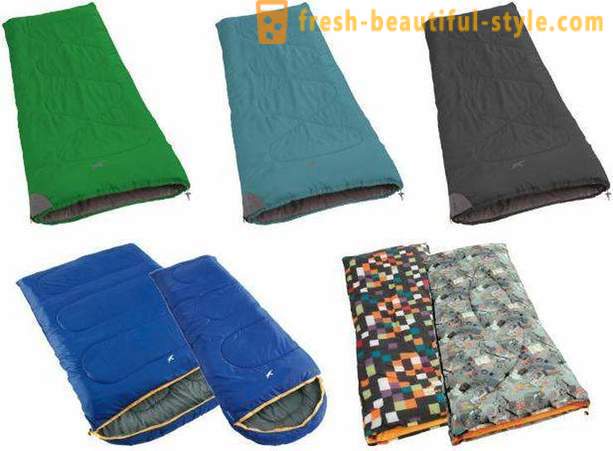
3. Sintepon
How to choose a sleeping bag for infrequent trips to the warm season? The best option - a model with polyester fiber filling. This is by far the cheapest filling. Sinteponovye sleeping less absorbs moisture and dries quickly. But do not expect much from the cheap stuff. 1-2 sintepon season gets off, compressed, and the product is not subject to exploitation. Besides sleeping with the filler can not be tightly packing. This accelerates wear.
Manufacturers are constantly working to improve the quality of sleeping fillers. And they do it very well. If you focus on the price of the product, here everything will depend on the quality of the filling. The cheapest small thermal insulating materials temperature. Their fibers retain a portion of the air during packaging. The result is voluminous and cooler sleeping. During the packaging of products with a more expensive air filling in the fibers does not remain, and they are quickly restored when unpacking. These sleeping bags travel (how to choose the right model, you will learn from this article) have a small volume and weight, as well as excellent retain heat.
4. Nylon
Modifications are used as the facestock in most sleeping. For options with a feather-filled even created a special fabric: Ultrex, Pertex and others. They are breathable, water-repellent and vetrozaschischayuschie. These properties will not allow moisture to get inside, and thus will prevent wetting insulation. Sometimes, the outer layer is made from membrane tissue, fine diverting moisture outwardly. By the way, if you are thinking about how to choose a sleeping bag with maximum comfort inner surface, then stop for a model with a cotton cloth. It is most pleasing to the body.

How to choose the size of a sleeping bag?
It is important to consider your anatomic features. From sleeping bag in which you do not fit, or that barely gets to the chest, will be no good. On the other hand, in the bag sink and impractical, particularly since the larger bag, the greater its weight. Therefore, there are products with different parameters. People with 48 size garments suitable sleeping 195 cm x 145 (M), with a size of 56 - 220 x 180 cm (L). But if the height above 185 cm, it is worth buying XL.
It is useful to estimate the bag on her figure. Ask about the seller and try on a sleeping bag in the store. Climb inside the selected model, fasten the zipper, tighten the hood and leave the smallest possible hole. Only in this way you can check whether you fit sleeping bag length. However, neither in the legs or in the hood should be no fabric tension, otherwise there will be "cold spots", and in the area of hand, it is desirable to have a free space. The most optimal option - it is when at a slightly bent legs pulling the side walls is minimal.
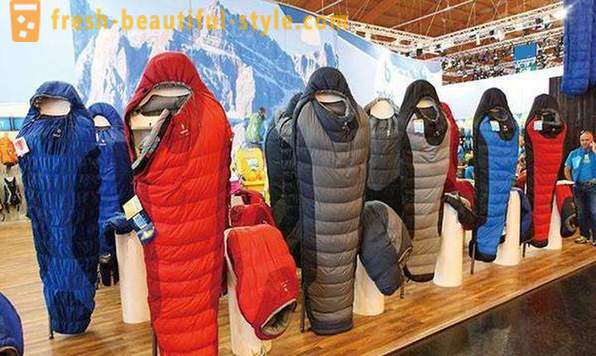
How to check the quality?
Let's say you've decided to buy a tourist sleeping bag. How to choose the best quality model? It's not hard. Good sleeping bags have a large zipper opening and closing without jamming. The filler should be evenly distributed over the entire area of the product and not to create lumps. It is desirable that a sleeping bag was quilted in several places. Then, the filler will not exactly get off. We list a few criteria that distinguish a good sleeping bag. How to choose - you decide. Just keep in mind the nuances of the following:
- presence of straps, zipper closing.
- Absence through quilted seams.
- A special clasp (button or hook) near the hood. Thanks to her, you will forget about spontaneous rasstogivanii dream lightning.
- The dark fabric. Very relevant for travel. It heats up quickly and allow to dry the bag as soon as possible.
- The protective tape on the inner side of the zipper (prevents damage and prevents "zakusyvanie" tissue).
- Cuff, closing the entrance to the sleeping bag.
- Lightning in the bottom of the sleeping bag for him turning inside out and fast drying.
- Absence of traces of sealing lines and curves.
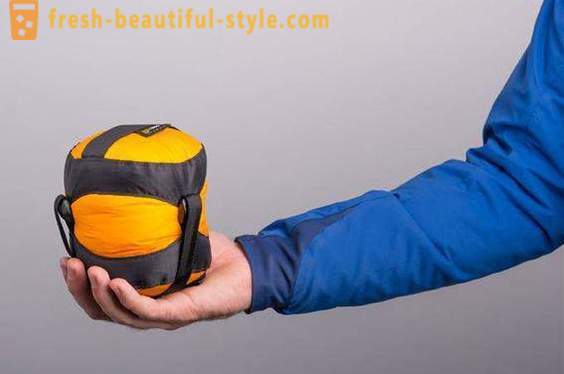
Package
We have already told how to choose the right sleeping bag. It remains to consider the last important point - its packaging. The hiking tours she plays a pivotal role, as too much space in your backpack weight in gold. Roll a sleeping bag in a roll is not effective, so before you buy, check with the seller, is there a complete compression bag. To most modern models it is attached, which can significantly reduce the product size. Pack a sleeping bag takes place by its chaotic pushing into cover, starting from the bottom. It's easy and effective! Even the manufacturers recommend only this method of packaging.
Conclusion
Now that you know how to choose a good sleeping bag. By purchasing the appropriate option and observing the simple rules of operation, you can use it for several seasons. Upon awakening, do not just pack a sleeping bag in the boot. Let a little air out. In the evening unfold and beat the bag in advance. As for the washing of articles in the machine, use only gentle treatment (without spinning). Sleeping dried at room temperature, and is stored only in the expanded state and in a dry place.













































